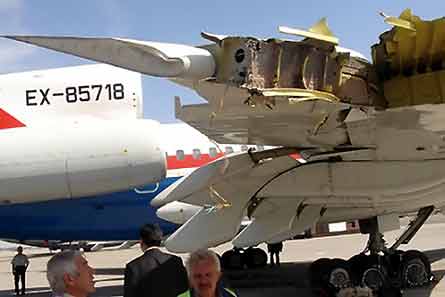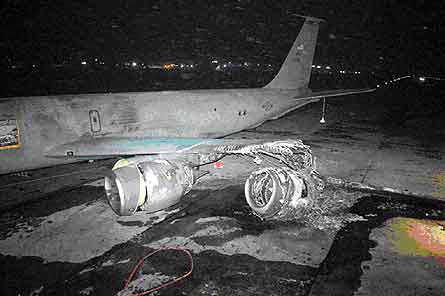A US military accident investigation board (AIB) under the auspices of the US Air Force's Air Mobility Command has determined that a Kyrgyz controller at Manas airport in Bishkek, Kyrgyzstan was "primarily at fault" when a Tupolev Tu-154 struck a Boeing KC-135R tanker at the airport on the night of 26 September last year.
The accident resulted in heavy damage to both aircraft, but no fatalities. Contributing factors include KC-135 aircrew activities, conflicting airport notices and the actions of a tower liaison employed by the US government to facilitate communication between the tower and US aircrews.
The USAF released an amateur video of the resulting fire at the airfield as part of the investigation (below).
In a report issued on 20 December, investigators revealed that the KC-135, with three people on board, had landed at the airport at 20:03 after a mission over Afghanistan. Confusion over taxiing instructions caused the KC-135 crew to make only a partial right turn off the active runway before stopping for further clarification. The controller meanwhile cleared a Kyrgyzstan Airlines Tu-154 for take-off. The departing aircraft's right wing passed under the outer portion of the KC-135's left wing tip, but clipped the number one engine (left outboard engine), destroying it and a portion of the wing in the fiery aftermath. Despite losing about 2m (6ft) of its right outboard wing in the collision, the Tu-154, with 52 passengers and nine crew, was able to take off and return to the airport for a successful emergency landing.
 |
|---|
The Tu-154 (above) and the KC-135 (below) suffered extensive damage in the runway collision, but there were no fatalities |
 |
Though the AIB says the "principal" cause of the mishap was the Kyrgyz controller clearing the Tu-154 for take-off before making sure that KC-135 was clear of the runway, the board also cited several contributing factors:
- The Kyrgyz controller's instruction to vacate the runway at taxiway "Golf" after dark conflicted with a published Notam prohibiting using the taxiway at night. Further, the liaison "did not clarify the apparent discrepancy".
- After questioning the controller's instructions to vacate the runway at Golf, the liaison instructed the KC-135 to hold short of "Alpha", a taxiway further removed from the runway. The KC-135 crew "misperceived" the liaison's instructions and responded, "holding short of Golf". The liaison "failed to catch the read-back error".
- The controller failed to maintain awareness of the KC-135's location.
- The liaison "failed to maintain situational awareness and intervene when the controller's actions endangered the KC-135 and crew".
The BBC on 21 December reported that the Kyrgyz foreign ministry had seen only a brief summary of a translated version of the report and had objected to the USA issuing its final report to the media before a translated version of the entire report could be delivered.
The USAF says that the investigation had been completed on 14 November and a translated version of the report hand-delivered to Kyrgyzstan by the US Department of State and Gen Gary North, commander of 9th Air Force and US Central Command Air Forces, before the release of the final report.
Source: Flight International




















